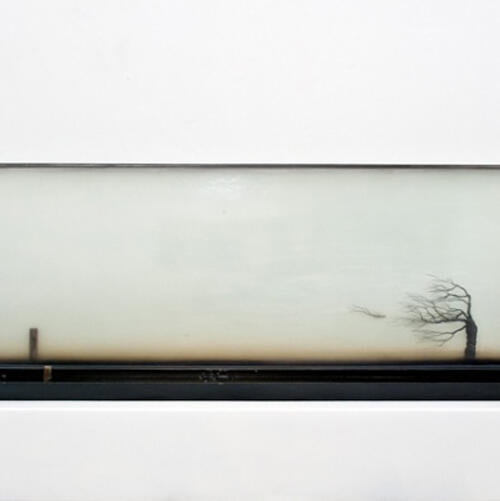Luis Fernando Peláez
Sextante, Bogotá
The name Luis Fernando Peláez is already looked upon as the synonym of a starting point toward silent, winter landscapes, where a poetics of grays take us to a sort of longing, to the innermost nostalgias enclosed in his sculptures featuring almost photographic places that seem to have emerged from a painting, and that, installed in the reality of three-dimensional objects, contain the human condition in its loneliest moments. His are works imbued with a desolation that is, however, transcended, because there is in them a sublime poetization of the relationship between landscape and nature built on the basis of constant elements – man, home, world, cosmos − that refer us to the transit of humanity along the frontier between the ephemeral and the infinite.

The landscape tradition, from the bucolic Italians, through the mythical painter Caspar David Friedrich, to Wyeth, is vast and unique. In Colombia, landscape painting is so deeply rooted that writers like Caballero Calderón consider it the fourth dimension of our being.
In his exhibition “El río” (“The River”), at Sextante Gallery, Peláez shows the freshness of his first works, the insinuation of surrealist assemblages made with a sort of playful innocence, a game that refers us simultaneously to the boxes created by Cornell − a conveyor of clarity of transcendent realities − and to Atget’s photographs of solitary cities.
In this exhibition we are presented with two facets of this landscape or fable, myth or legend, which Peláez shares with us. On the one hand, the horizontal line invites us to the contemplation of some tragedy, made explicit though the tree (made of wire) which shakes to the rhythm of the storm that passes and sweeps everything that exists. It is an oppressive horizontal line, which marks the river’s course.
On the other hand, he presents us works with a background of photographs of car lanes, a yearning for traveling, an invitation to adventure, emphasized by lines in perspective, diagonals that highlight vanishing points which break the monotonous and arrhythmic horizontal of the landscape and invite us to pursue the dream, to leave the oppressive confinement of the monotonous flow of the river or life. The work that brings us closer to this incitement to travel is, precisely, a suitcase, an image-object that condenses all the suggested yearning. It is a poetics of nostalgia and space, a reverie that transcends us, turning into a real space that encompasses us and ends up inhabiting the whole being. El río evokes a line by the poet Blanca Andreu “…something is missing and it has to be named…” The works by Luis Fernando Peláez bring us close to the space where the unspeakable is named.
-
 From the series “The River”. Acrylics, resins, metals, objects, 25.6 x 13.8 x 78.7 in. Photography credit and courtesy the artist. De la sertie “El Río “. Acrílicos, resinas, metales, objetos, 65 x 35 x 200 cm. Crédito y cortesía del artista.
From the series “The River”. Acrylics, resins, metals, objects, 25.6 x 13.8 x 78.7 in. Photography credit and courtesy the artist. De la sertie “El Río “. Acrílicos, resinas, metales, objetos, 65 x 35 x 200 cm. Crédito y cortesía del artista.




